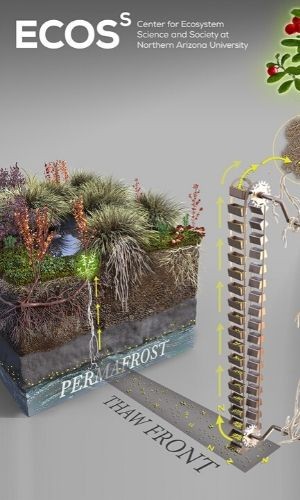Until now, the permafrost in the Arctic Tundra has remained as it has been from the last ice age on earth. It seems there are alarming developments that are gaining attention, from scientists at Northern Arizona University in the US.
The finding will alter how nutrients are obtained from the cold permafrost of the cold tundra. This is happenings as the earth is suffering from changing its chemical processes, more changes are trickling to one of the most remote places on the planet.
It seems that a simple Connector Fungi is providing clues as to why increased nitrogen is released more. Change in the tundra is relevant because it holds clues to the changes during the last ice age. Somehow, they found a way to collect the nitrogen better, as was discovered by researchers.
This find does not match with known parameters, how plants and connector fungi achieved this co-dependent relationship. Rebecca Hewitt from the Center for Ecosystem Science and Society (Ecoss), conjectured that plant was the one thought to access nitrogen.
Plants use roots that were extended deeper, they were the ones capable of accessing food from permafrost. From the looks of it, the connector fungi helped plants do it in a symbiotic relationship. It can indicate that the fungi are enabling the plant to collect nitrogen in the permafrost layer.
Everything is connected and how heat is increasing all over the world. One troubling aspect of connector fungi is how much nitrogen will be increased, as the arctic permafrost disappears slowly. One bright side to all the increased nitrogen that will show where everything ends up, so researchers can dig further into the phenomenon.
Some factors to consider is the increased nitrogen released should give more clues that will help scientists understand better.
A) As more plants are present in the permafrost soil will add to the current level of nitrogen in the atmosphere.
B) More connect fungi will help release more nitrogen, to lessen the carbon there is now.
C) Increased incidence of connector fungi will have more plant biomass, to lessen the carbon in the air.
D) This is a natural mechanism should remove more carbon, as the permafrost melts.
Determining what organisms consuming more nitrogen from the permafrost is important to determine. This reasoning was important for researchers to draw the right conclusions from the study. Further investigation from Hewitt and the other researchers, used an isotopic tracer or Nitrogen 15 on the thaw front. A thaw front is where the permafrost meets the active soil layer, which is not frozen too.
Nitrogen 15 is heavier than Nitrogen-14, and it will show where the nitrogen goes when injected with long needs to deliver it to the soil. After 24-hours, plants and connector fungi are examined how the Nitrogen 15 got absorbed into it. Upon checking the plants to see what fungi absorbed the most nitrogen. It seems plants got nitrogen-15 from the connector fungi when examined by the scientists these were observations.
A) More nitrogen absorbed into plants or in connector fungi leaves less nitrogen in water changing to nitrous oxide.
B) Knowing the exact amount of nitrogen, connector fungi can store, and how it fertilizes more plants.
C) Why do the fungi store some of the nitrogen, and let's go of the rest?
A connection between the increased nitrogen, with the connector fungi, should be studied, and documented especially how the permafrost is affected by it. More research will yield more data to explain what is happening to the permafrost in the tundra.
Related Article: Connector fungi offer new clues to the fate of nitrogen in warming tundra

https://www.newswise.com/legacy/image.php?image=%2Fimages%2Fuploads%2F2020%2F01%2F8%2FHewitt-newcoverfigure-Ecoss.jpg&width=1280&height=1280










!['Cosmic Glitch' in Einstein's Theory of General Relativity Could Be Explained in This New Scientific Tweak [Study]](https://1721181113.rsc.cdn77.org/data/thumbs/full/53435/258/146/50/40/cosmic-glitch-in-einsteins-theory-of-general-relativity-could-be-explained-in-this-new-scientific-tweak-study.jpeg)



